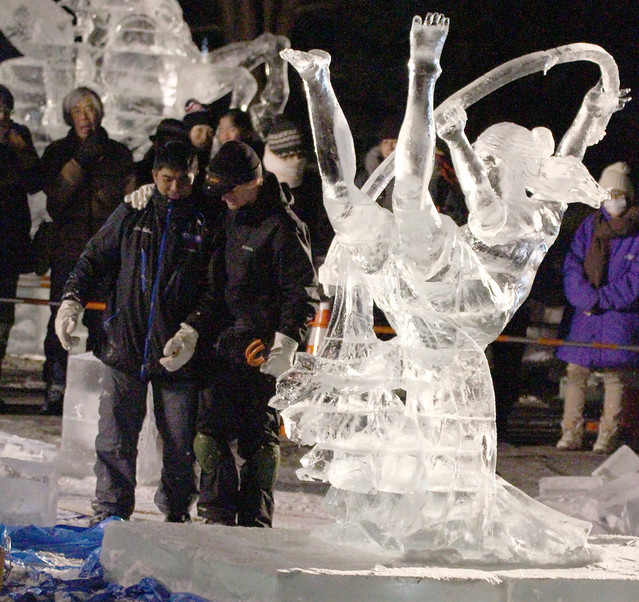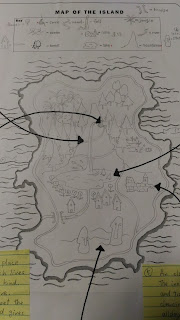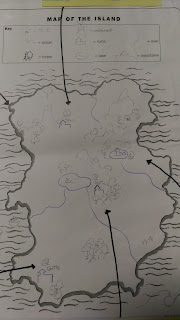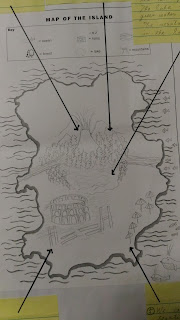
English language school in the heart of the Japanese Alps, and English language learners sharing their experiences online. Teachers post regular items about teaching, learning tools, events in the school, their day to day experiences living & working in a foreign country. Students post on whatever takes their fancy - book reports, festivals in home towns, postcards from business trips etc. A little Brit of England in the guts of Japan!
Monday 30 January 2017
After reading - The Quest
Do you know the CHATUCHAK weekend market in Bangkok?
If no, I recommend to you to visit the market in the weekend.
As you can see, the market is only held on Saturday and Sunday. It's very big market and many tourists visit this market every weekend. The place is 2.5 times as large as Tokyo Dome and 0.2 to 0.3 million people come per week.
There are everything you want, souvenir, clothes, fruits, restaurants, furniture, bag, hat, shoes, lamps, figurine of animals,,,everything!! And all of them are very reasonable prices.
When I go to the weekend market, I enjoyed to buy small pouches made by straw, a bracelet of natural stone, accessories, hat, table cloth, T-shirts, and so on.
As the place is too large, I recommend to buy it when you like it. Once you passed the shop, you might not be able to come back the original place.
In addition, there is no air conditioning. You may not be able to walk for a long time as it's too hot, the average temperature is around 30℃ and highest temperature is 39℃.
Please enjoy your weekend in this market when you visit Bangkok.
Saturday 28 January 2017
Have an ice evening!
Last weekend saw temperatures plummet appreciably here in Matsumoto, with local & international ice carvers rubbing their hands enthusiastically!
Rumours have it that this event might not continue - which is a crying shame as it is one of the most under-rated nights out locally.
Night out? Yes! I can't remember the last time I went in daylight. Seeing the professionals and keen amateurs chipping, sawing, carving, blow-torching their creations into life is a treat. You need to be patient - wrap up well - and hot sake has excellent thermal properties...give a carton over to the lads & you'll be friends all night (and have access to the heating tent!).
Through the night designs change, bits fall off or ambitions need to be pulled back. Attachments carefully chiselled into shape get hoisted up to height on the forklifts waiting for work - snowflakes, horns, legs, carp, penguins - you name it!
For the photographer a delightful ongoing vista. Men-at-Work portraits, icy black & white super contrasts, shadow play & backlit studies. And a very cold trigger finger! (Keep your spare battery in a deep warm pocket, by the way). I really enjoyed my Saturday night out - and had to laugh at the white-lens warriors who turned up too late on Sunday morning as the bell rang at 6am to announce competition time was finished (put your tools down & step away from the ice).
When the sun comes up you do have the amazing Alps as a backdrop, but the magic is gone as the dawn approaches; the statues' poses are set and the decay starts almost immediately...before noon limbs have fallen off, carefully carved features have melted into tell-tale puddles.

Rumours have it that this event might not continue - which is a crying shame as it is one of the most under-rated nights out locally.
Night out? Yes! I can't remember the last time I went in daylight. Seeing the professionals and keen amateurs chipping, sawing, carving, blow-torching their creations into life is a treat. You need to be patient - wrap up well - and hot sake has excellent thermal properties...give a carton over to the lads & you'll be friends all night (and have access to the heating tent!).
Through the night designs change, bits fall off or ambitions need to be pulled back. Attachments carefully chiselled into shape get hoisted up to height on the forklifts waiting for work - snowflakes, horns, legs, carp, penguins - you name it!
For the photographer a delightful ongoing vista. Men-at-Work portraits, icy black & white super contrasts, shadow play & backlit studies. And a very cold trigger finger! (Keep your spare battery in a deep warm pocket, by the way). I really enjoyed my Saturday night out - and had to laugh at the white-lens warriors who turned up too late on Sunday morning as the bell rang at 6am to announce competition time was finished (put your tools down & step away from the ice).
When the sun comes up you do have the amazing Alps as a backdrop, but the magic is gone as the dawn approaches; the statues' poses are set and the decay starts almost immediately...before noon limbs have fallen off, carefully carved features have melted into tell-tale puddles.

Friday 27 January 2017
Augmented reality island poster
In an attempt to explore the potential of Aurasma (read more about it here on a previous posting) and bringing in an extra dimension (the augmented kind) into the classroom, my bi-monthly housewives class went on a journey into uncharted territory: using a smartphone app to expand their learning and augmenting analogue into digital.
This project, which spanned a couple of lessons, revolves around a remote mystery island. We began by learning vocabulary for types of terrain, points of interest and landmarks, alongside adjectives which they collocate to. This served as a base to be able to be more descriptive when it came to summarising the key features of the island.
2 weeks later we regrouped and ironed out any errors in the writing. What I wish I had done in hindsight is added in a listen and draw activity, where everyone paired up and listened to their partner’s description of their island and re-drawing the island as it is described. It would have really helped activate all of the useful language we had studied. Tunnel vision focusing on the final output with Aurasma may have obscured my vision here!
Alternatively, we split into pairs of speakers and listeners. The role of the speaker was to describe the special interest points on their map, first with their written summaries in hand, and after a few practise rounds over their summary to their listening partner, whose role was then to prompt when the speaker when they stumbled. For the finale, the listener video-recorded their partner (finally starting to go digital) much to the objection of those involved. At this stage they had rehearsed and practised their summary, not just reading out loud and were ready for the big stage. Even if they didn’t believe it themselves at the time.
I then went through the process of embedding the videos into everyone’s poster, using the images on their islands as trigger images. Jaws on the table when given my phone to point at their poster, and out pops an audio/visual combo of the creator describing what exactly it is that they are looking at. Pretty cool! It’s quite rare to be able to have a record of what students have produced orally and be able to showcase it too. Aruasma is the perfect medium to do so, and has a great WOW factor. It can make your 2D poster, into a living, talking, interactive masterpiece!
Thursday 26 January 2017
Monday 23 January 2017
Killing time with a jigsaw & YLE Starters practice!
As I have written in the description, this was not a planned practice - we were waiting for her study-buddy to arrive and had already put the massive jigsaw together and talked about the things we could see.
The smaller cards I'm holding would be larger in an actual Cambridge YLE Starters speaking test (and the picture a lot simpler!); there would be eight to choose from, and at most the candidate would be asked to place only three into the picture (so we overdid it a bit here!). Note though, we've never done this before and were coming across new words (which we have not learned eg frog, kite) which we might not know, but we do know they were not apples or fish! Not all the vocabulary is in the Starters word list either - never mind!
My students have not come across prepositions before, so we were learning (and teaching each other) as we went. You can see the dynamic changes instantly with the boy joining us? The girl assumes the role of explainer & intermediary, supporter etc. This would not happen in an actual test - one at a time please! The examiner would have a script & time-plan to follow, too. We would be sat at angle like this, or next to each other. I think it is clear that young learners CAN DO if given time & a fair chance; they don't need translations or super-genki distractions!
We are going to be adding more Cambridge English speaking test practice videos on our Youtube channel this year; you can already find loads of examples of our learners making/singing/doing/giggling (a lot)...mostly fun & games at Luna but this I think the proof of the pudding: a serious CAN DO pay off.
My students have not come across prepositions before, so we were learning (and teaching each other) as we went. You can see the dynamic changes instantly with the boy joining us? The girl assumes the role of explainer & intermediary, supporter etc. This would not happen in an actual test - one at a time please! The examiner would have a script & time-plan to follow, too. We would be sat at angle like this, or next to each other. I think it is clear that young learners CAN DO if given time & a fair chance; they don't need translations or super-genki distractions!
We are going to be adding more Cambridge English speaking test practice videos on our Youtube channel this year; you can already find loads of examples of our learners making/singing/doing/giggling (a lot)...mostly fun & games at Luna but this I think the proof of the pudding: a serious CAN DO pay off.
Saturday 21 January 2017
Friday 20 January 2017
Mind the (Learning) Gap - relevant materials for teens in EFL classrooms
We have been so busy at Luna over the last year or so exploiting the wonderful resources that are Mary Glasgow magazines, that we have completely forgotten to write about them!
Published by Scholastic, and available for learners across 5 carefully graded (CEFR) levels from A2 to C1 (Cambridge YLE Flyers/KET for Schools to Cambridge Advanced) and in five editions per year, the challenge is really upon learner & teacher to motor through all the amazing content quickly enough!
We promise to keep you better informed of our experiences this year - we already had the third of five editions for 2016-17 land on our doorstep though!
A theme with the Crown (CEFR B1 level) magazine this year (the publisher's "year" sticks to the British school calendar which runs October to September) is a double page spread per issue on one of London's Underground Lines. So far, we have run the rule along the Central & Circle Lines. I think this is a fabulous idea - and extremely well set out - with highlights and photos of the best places to go sightseeing & which station is closest...historical & cultural information too. Also very practical - London IS the world's most visited tourist destination after all, and the map is an iconically simple representation of a very messy bowl of spaghetti!
A lot of Japanese learners can relate to major underground networks - more people pour through Shinjuku station (in Tokyo), for example, than the entire population New Zealand. Per day! And a lot of internationalised students, or returnees if you like, have tackled an underground network somewhere along the way. How often do you struggle to find relevant (and current) material for travelled & more fluent/capable kids if you are running a school/teaching outside eg the Circle Line?
 We've had a redundant board game in the cupboard for yonks, which is a great game but impossible to give any relevance to apart from the odd "I'm going to London next month" panic scenario! Now? most popular game in the building as our pre & young teens want to roam around London checking out the sights and transfer urgently to get Hamley's, see Big Ben and get to Wembley Stadium!
We've had a redundant board game in the cupboard for yonks, which is a great game but impossible to give any relevance to apart from the odd "I'm going to London next month" panic scenario! Now? most popular game in the building as our pre & young teens want to roam around London checking out the sights and transfer urgently to get Hamley's, see Big Ben and get to Wembley Stadium!
As we adopted these magazines to replace our reliance on Oxford University Press's Story Tree (you fools, brilliant YLE resource for EFL chopped off at the knees) we went to bat making resources to cover the entire glossary for each article in each of the five magazines on Quizlet. This allows us to flip our classrooms - teachers get early editions as institutional subscribers & we roll-out sets (per article) well in advance. The subscription deal with Scholastic is SO attractive, and the resources available online so staggeringly comprehensive & archived, we feel the very least we can do is share.
Published by Scholastic, and available for learners across 5 carefully graded (CEFR) levels from A2 to C1 (Cambridge YLE Flyers/KET for Schools to Cambridge Advanced) and in five editions per year, the challenge is really upon learner & teacher to motor through all the amazing content quickly enough!
 |
| Please change here for Tower Bridge! |
A theme with the Crown (CEFR B1 level) magazine this year (the publisher's "year" sticks to the British school calendar which runs October to September) is a double page spread per issue on one of London's Underground Lines. So far, we have run the rule along the Central & Circle Lines. I think this is a fabulous idea - and extremely well set out - with highlights and photos of the best places to go sightseeing & which station is closest...historical & cultural information too. Also very practical - London IS the world's most visited tourist destination after all, and the map is an iconically simple representation of a very messy bowl of spaghetti!
A lot of Japanese learners can relate to major underground networks - more people pour through Shinjuku station (in Tokyo), for example, than the entire population New Zealand. Per day! And a lot of internationalised students, or returnees if you like, have tackled an underground network somewhere along the way. How often do you struggle to find relevant (and current) material for travelled & more fluent/capable kids if you are running a school/teaching outside eg the Circle Line?
 We've had a redundant board game in the cupboard for yonks, which is a great game but impossible to give any relevance to apart from the odd "I'm going to London next month" panic scenario! Now? most popular game in the building as our pre & young teens want to roam around London checking out the sights and transfer urgently to get Hamley's, see Big Ben and get to Wembley Stadium!
We've had a redundant board game in the cupboard for yonks, which is a great game but impossible to give any relevance to apart from the odd "I'm going to London next month" panic scenario! Now? most popular game in the building as our pre & young teens want to roam around London checking out the sights and transfer urgently to get Hamley's, see Big Ben and get to Wembley Stadium!As we adopted these magazines to replace our reliance on Oxford University Press's Story Tree (you fools, brilliant YLE resource for EFL chopped off at the knees) we went to bat making resources to cover the entire glossary for each article in each of the five magazines on Quizlet. This allows us to flip our classrooms - teachers get early editions as institutional subscribers & we roll-out sets (per article) well in advance. The subscription deal with Scholastic is SO attractive, and the resources available online so staggeringly comprehensive & archived, we feel the very least we can do is share.
Tuesday 17 January 2017
Invisible writing - get those reluctant scribblers going
In September 2010, Peter Ross made a presentation at Shinshu JALT here in Matsumoto on Invisible Writing. It remains one of the most practical & helpful learning tips I have come across over the years of workshops & conferences I have attended. It is a technique I have occasionally deployed with my learners aiming for exam success.
A never-ending frustration with my learners - and I suspect a nationwide issue at least here in Japan - is how slowly ideas are formulated into words, and how slowly those words are organised/connected/embellished/collocated/contrasted/developed...brainstorming is not a concept familiar to very many students I have taught over the years, and certainly not as a communal effort after primary school age.
An observation as well, from hours and hours spent invigilating Cambridge exams, is how poorly (if at all) candidates plot out their writing. Time is critical in an examination especially, but skipping the thinking & planning stage is a massive mistake - which writing invisibly illustrates beautifully!
So let's assume we have focused on the writing task and identified:
 |
| Keep that plan handy - or you'll get lost! |
An observation as well, from hours and hours spent invigilating Cambridge exams, is how poorly (if at all) candidates plot out their writing. Time is critical in an examination especially, but skipping the thinking & planning stage is a massive mistake - which writing invisibly illustrates beautifully!
So let's assume we have focused on the writing task and identified:
- The audience - who are we writing to and why?
- The format - is this a letter? an email? a memo? a report? an essay etc?
- The voice - formal or informal? Contractions, abbreviations & emojis going to be suitable?
Let's also assume we have determined the time we have available for this - after the planning stage (please give that about 10 mins if you are at FCE level), and the target word count. Let's also assume we have written on A4 before & know approximately how many words we can get on a line so we know approximately how many lines we need to write (and not count every word back every two minutes?!)...
What stops writers even starting?
- Blank paper panic
- allergy to writing joined up ideas
- lack of muscle memory - how often does anybody use a pen these days?
- lack of confidence in vocabulary range, grammatical accuracy, spelling, my own voice
- time stress
Familiarity with the task & a checklist of how the writing will be assessed helps enormously. Small steps first, and build on what you CAN do. Get those hands & brains trained!
What slows the writer down?
- erasers
- re-reading or editing on the go
- re-thinking the plan
- winging it
- word counting
When you are planning or blitzing ideas, making a mess is part of the gig. Scribble everything down as it comes to mind & don't stop. Scrap paper is literally that - it goes in the shredder. Once you have blurted ideas onto paper, organise quickly with arrows & numbers. Add extra words or replace repetitions, order logically into paragraphs. Contemplate spelling at this stage & use another word if you are stuck - don't rub stuff out or compose fully fledged sentences.
So far, this invisible writing is kind of invisible! You will need a thin plastic 'wallet' for loose leaf papers, that a pen will be able to make an impression through, within which a sheet of carbon paper sandwiched between a sheet of lined paper (top) & a sheet of plain paper below. Make sure the carbon paper is the right way up. A pen that doesn't work - I prefer a pen the students will usually use (no not a pencil) or even the wrong end of a paint brush! The whole point is that the writer will not be able to see what they have written.
 |
| Can you see what we just wrote? |
I promise this exercise will transform the way your writers will think about & approach writing tasks. As they are unable to see what they have done/are doing, the following tends to happen:
- focus carefully on what they are actually doing & where they are on the paper, physically. This stops day-dreaming dead!
- extra care in writing neatly
- careful adherence & constant referral to the plan - get everything 'in'
- maintain a flow (stopping to do anything else means you lose your place)
- no editing or re-reading
- erasers are out of the equation
- writers 'see' their writing in their heads & concentrate hard to keep it there
When your writers have finished, ask them what they were doing. Let them identify what has changed in their writing process. One thing my writers never do - yours too? - is re-read their work afterwards critically. Invisible writers can't wait to review their work...spelling, missing punctuation, word order, grammar. You will never see your students keener, and you may even have to let them do a re-write (that precious second draft!) if they ask.
I love invisible writing - does it work for you?
Subscribe to:
Posts (Atom)







